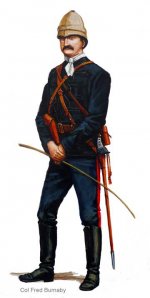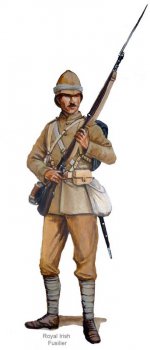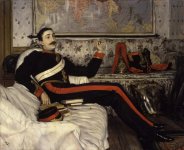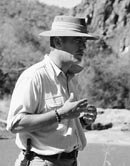Here is more info on the book as posted by the author, Mike Snook on the Victorian Wars Forum
Go Strong into the Desert
by mike snook » 13 Mar 2010 06:40
Hello folks
With Mark's blessing I am now able to provide some information on one of two Sudan books I have been working on over the past two years. We'll come to the second one in due course (which is a mainstream publishing production and won't be out until early next year), but the first one is finished and being prepared for publication over the course of the summer. As it has been commissioned within a specialist domain, you won't be able to get it in the usual Waterstone's/Amazon type places. More of that in a moment.
It is called 'Go Strong into the Desert - The Mahdist Uprising in Sudan 1881-85. A Military History and Uniform Guide.' The main title is derived from the text of an anonymous telegram sent to Wolseley from London during the Nile expedition. I believe the book will be in what you might call the soft back glossy format. I don't yet know what it will cost - but something between 20 and 30 quid I imagine. It contains a 70,000 word account of the uprising and is copiously illustrated, with a very high prevalence of colour plates of various kinds, of which more in a moment. The main narrative text focusses on the uprising as a military event, with the bulk of it devoted to detailed accounts of the principal battles. The following are well covered; the early and invariably disastrous Egyptian attempts to get after Muhammad Ahmad, the siege of El Obeid, Hicks Pasha and the Senaar and Kordofan expeditions, Osman's attack on Tawfiq Bey at Sinkat, the Tahir Pasha/Moncrieff expedition (the real 'first' El Teb), First El Teb (The Val Baker Disaster), Second El Teb and Tamai, the Siege of Khartoum (including a detailed description of the defences and coverage of the major sorties and setpiece actions around the city), the battles of Abu Klea, Abu Kru, Kirbekan, Hasheen, Tofrek and Giniss. I am told by those who have read it that the text is fast moving but nonetheless packed with intricate military detail along the way - which is nice because that's how I planned it!
In addition to the text there are about 15 extremely detailed tables describing British, Egyptian and Mahdist orders of battle. All the setpiece battles itemized above are covered - unit names (correctly expressed), brigading arrangements, unit strengths, casualties, Mahdist commanders properly transliterated, (you don't see that everyday), commander's names, ranks, initials, decorations etc all individually researched from the Army List. By the way the first name of every officer menioned in the text is also given, and every unit title is correct by the Army List of the date in question - your usual sloppy 'Major Jones's battery' will simply not do for this production! There is a wealth of detail here which you won't find elsewhere - or if you do you'll have to dig bloody hard!
For illustrations we draw extensively on my personal collection of matters Sudan 1881-85:
There are many ILN and Graphic sketches, particularly by those who were first hand witnesses like Melton Prior, Frederic Villiers, G.D. Giles, C.E. Fripp and others, but also the more splendid ones by Richard Caton Woodville who, while he is not to be relied upon as a source for dress, is nonetheless a magnificent war artist.
There are also a good many modern colour photographs from the battlefields taken during my recent service in the Sudan. El Teb, Tokar, Tamanieb, Abu Klea, Abu Kru (or what I believe to be Abu Kru - but that's too long a story for this post), Mernat Island, Wad Habeshi, Hasheen and Suakin Island all feature.
Even more splendidly, there are 35 or so full colour uniform plates by a quite excellent artist/sculptor/designer and chum of mine called Michael Perry. These cover not just the British Army's orders of dress, that we know about, but many interesting early Egyptian and Sudanese uniforms, as well of course as the Mahdist forces. There are also rather nice personality portraits of Val Baker and Fred Burnaby. We waste nothing on ceremonial uniforms - these are all plates of what people wore in battle. Michael provided the skill and imagination and I provided the good history underpinning the plates. The plates themselves are real beauties - Michael has really done the subjct proud.
Michael Perry is best known as one of the fomidably talented 'Perry Twins', Michael and Alan, who are probably the best sculptors of wargames figures working in the world today. By day they work for the Games Workshop empire, but by night they do their own thing for 'Perry Miniatures'. It is Perry Miniatures that will publish the book. While the book will be highly attractive and useful to wargamers, modellers, re-enactors and other military hobbyists, it is a history book first and foremost, so will be equally if not more attractive to VWF members with a historical fascination in the Sudan campaigns. I don't yet have a publication date but will publicize it here when known - June/July-ish perhaps. To acquire a copy you will have to order it from the Perry Miniatures website which, at some point in the not too distant future, will offer it for pre-order. I'll let you know when it is up. There are likely only to be a couple of thousand copies to begin with, so there'll be the quick and the dead, though when the first lot go there will be more - but doubtless an interval too.
Hope that fairly describes what's on offer - I detect that this will appeal to a goodly number of VWF members, so I thought I'd best tip you off in advance. I hope those who buy it, like it and am quietly confident you will!! Now it's time to sleep....for about a week!!
Regards as ever
Re: Go Strong into the Desert
by mike snook » 20 Jun 2010 05:06
Mike
Morning all,
I now have a few more details on the publication of Go Strong into the Desert. It will be out at the end of August. 216 pages, 40 original colour plates and 200+ other illustrations including some of my photography from the battlefields. It will cost £25 plus p & p (UK and BFPO £3, Europe £5 and rest of the World £9). A Perry Miniatures publication available from:
www.perry-miniatures.com
Be aware that the pre-order facility is not yet up.
I have just seen the cover artwork by an artist called Karl Kopinski, which shows hand-to-hand fighting at Abu Klea, and is absolutely brilliant.
Regards
Mike







